Design
The Moto Z2 Play is beautiful, but only at first glance. You pick it up - a thin (6 millimeters), pleasant to the touch metal device. There are no those moronic plastic strips for antennas crossing the body - instead, they made a solid insert around the perimeter of the back cover. In general, at first you see a nice, well-built phone.
And then you pay attention to everything else. There are plastic inserts not only around the perimeter of the back cover, but also on the top and bottom ends, right in the middle - it looks ugly. Next to the fingerprint scanner there is a hole for the microphone. At first I tried to scrape it off, mistaking it for stuck dirt.
The scanner works well - not instantly and not error-free, but close to it. But as soon as the scanner gets dirty or your finger gets sweaty, the fairy tale ends. You have to either enter a password or wipe the sensor and dry your finger. If you are also sweaty-palmed like me, then there is nothing left to do but be sad.
By default, the scanner is just a sensor and nothing more. The navigation buttons are standard Android ones, on the screen. In the settings you can switch to gesture control using the fingerprint scanner, but in my opinion this is not very convenient.
Many people don’t like the huge bulging “tablet” with a camera and a two-color flash. In my opinion, she looks, on the contrary, nice. Moreover, it is located in the center, and therefore does not interfere in any way - the phone does not wobble when it lies on the table. But I don’t know who might like a huge magnetic crap to attach modules. It looks as scary as possible.
But these two problems are solved by the socket that comes with the kit. When you magnetize it to the body, the camera practically does not stick out, and the magnetic lock is not visible. But the socket is loose in its place, and it infuriates me - so I went without it. Although it is beautiful, I received it with wood coloring and texture.
And the Moto Z2 Play only one speaker - it is both conversational and multimedia at the same time. But it’s okay, it sounds good, although without a stereo effect, there’s enough volume.
Motorola Moto Z2 Play Smartphone: Review
Dimensions - 3.9
Motorola Moto Z2 Play is a large 5.5-inch phablet with an original design. And with the help of removable covers and modules, it can look new every day.
From the front, the phone doesn't look that unusual - fairly wide frames, rounded corners, slightly convex ends and a fingerprint scanner under the screen. This year it became a little larger and changed its shape from square to oval. At first it is confusing: it seems that this is a control button, but in fact the control buttons are touch-sensitive and are located on the screen. Although in the settings you can remove these on-screen keys and control them using the scanner by pressing and swiping. In practice, this turned out to be not always convenient, but you won’t be confused by the proximity of different buttons.
Without replaceable covers, the back panel of the phone looks scary: a large, strongly protruding lens on top and strips of magnetic contacts on the bottom. But there is a Motorola logo and a decorating strip along the perimeter of the back. Together with a replaceable cover, the smartphone can be transformed into anything, just attach it to the magnetic mount. Interestingly, there are no speakers at the ends of the Moto Z2 Play; the earpiece above the display is used for music and other multimedia sounds. Separately, we note that the control buttons on the right are not the most convenient - the volume and power keys. They go together, in one row, and do not differ in size. In this situation, it’s easy to confuse them and press the wrong thing.
The dimensions of the smartphone are 156.2 × 76.2 × 8.8 mm, and the weight is 145 grams. The thickness is indicated taking into account the protruding lens; without it it is only 6 mm. Moto Z2 Play has become much lighter and thinner than its predecessor, but compared to some OnePlus 5 it looks a bit large. Operating such a phone with one hand is not so convenient.
Despite the removable cover, the Moto Z2 Play received a non-separable body with a non-removable battery. The build quality is excellent, and unlike its predecessor, there is no glass back that easily scratches. Interestingly, the smartphone is protected from splashes and drops thanks to some kind of water-repellent coating. But don't confuse this with water resistance - the phone cannot be bathed, although it should easily survive spilled coffee or a conversation in the rain.
Motorola Moto Z2 Play can be purchased in three colors - gray, gold and blue.
Screen - 4.6
The Moto Z2 Play's 5.5-inch AMOLED display pleasantly surprised us with its wide color gamut, although it sometimes lacks finer adjustments.
The screen has Full HD resolution (1920×1080 pixels), which is typical for such a diagonal. It's quite sharp, with a pixel density of 403 per inch (similar to the iPhone 7 Plus). Interestingly, the display uses an AMOLED matrix, which guarantees wide viewing angles and the highest contrast. We also note a good oleophobic coating and protective glass Gorilla Glass 3, which is not the newest, but not everyone has this.
The measured brightness range turned out to be quite good, wider than that of its predecessor - from 3 to 438 nits. The screen will be comfortable both in the dark and under the sun on a bright, sunny day. Nominally, the brightness is not that high, but it doesn’t need much - this is an AMOLED screen with infinite contrast. It’s nice that the display has a wide color gamut - 100% of Adobe RGB, which is very rare not only for smartphones, but also for laptops and even TVs. As we said, viewing angles are very wide, but at very high angles the screen gives off a greenish tint, as was the case with the Samsung Galaxy S7 and some other OLED screens. Color accuracy is quite high, but the display likes to add excessive saturation to colors. If this annoys you, then welcome to the settings - there you can tame the colors by choosing a "normal" color mode instead of the "vivid" color mode, which can be described as oversaturated.
Cameras - 4.4
The Moto Z2 Play takes very decent pictures with its 12 and 5 MP cameras. They are inferior to flagship ones, but can easily replace your inexpensive camera.
The parameters of the main camera can be called advanced: wide aperture with f/1.7, large pixels of 1.4 microns, laser and phase autofocus. The only thing missing is optical stabilization.
The camera interface is typical for Motorola smartphones. By swiping from left to right, settings pop up, and from right to left - previously taken photos. An interesting feature - along with choosing the focus point, you can quickly adjust the exposure. That’s probably all there is to it; only a small selection of shooting modes can be noted: “Photo”, “Video”, “Panorama”, “Slow Motion” and “Professional Mode”.
If we talk about shooting quality, the Z2 Play copes with this task adequately. The level of detail is high, without the typical fall-off at the edges of the frame, and color reproduction is quite accurate. But if you've selected the screen's "vivid" color mode, many colors will appear oversaturated when viewed from your phone. Double focusing sometimes misses, for example, if you shoot indoors, in such cases it is better to duplicate the frames. The HDR mode works quickly and efficiently, the photos look quite natural. In the dark, the smartphone lacks optical stabilization for clearer shots. At the same time, the noise level remains relatively small, at least it is not noticeable if you do not enlarge the image. You can also complain about shooting panoramas: they are shot in low resolution and take an indecently long time to process. The main camera can shoot video in 4K resolution or slow motion, 120 frames per second, but in HD (1280x720 pixels)
The 5 MP front camera does a good job of taking selfies, and there is also a flash and a personal HDR mode. Despite the moderate (for today) resolution, the frames are quite clear, even in rather difficult lighting conditions.
Photos from the camera of Motorola Moto Z2 Play - 4.4
Motorola Moto Z2 Play, HDR photo comparison
Photos from the front camera of Motorola Moto Z2 Play - 4.4
View original photos
Working with text - 5.0
The standard Gboard keyboard is available for working with text. It supports features such as continuous input, fast typing of numbers and symbols using additional markup. But they will have to be enabled separately in the settings. There you can also find a mode for use with one hand. Let’s also add that the keyboard is no longer so boring, the range of themes and colors has become much richer. It even became possible to download and set beautiful landscapes or even your own photo as a background.
Internet - 3.0
Initially, Moto Z Play comes with only the Google Chrome browser, one of the most popular in the world. The smartphone easily handles browsing with several open tabs. The main feature of the browser is the synchronization of history and bookmarks with the desktop version. Otherwise, nothing unusual, except perhaps the “Incognito” mode and double-clicking on the page, which will adjust the text scale to the pre-selected (or default) size.
Communications - 5.0
Moto Z2 Play has quite a top-end set of communications:
- dual-band Wi-Fi a/b/g/n
- Bluetooth 4.2 with A2DP profile
- LTE support
- A-GPS
- NFC chip
- FM radio.
It is curious that the predecessor did not have FM radio, and here it works without headphones. By the way, a separate mini-jack connector is provided for them. And USB type C is not simple, but with OTG support. That is, you can connect peripheral devices such as mice or hard drives to the phone. Moto Z2 Play works alternately with two nanoSIM cards. Interestingly, the tray has separate slots for them so as not to conflict with the memory card for space.
Multimedia - 3.5
Moto Z2 Play supports only the most common audio and video formats, it does not have the loudest speaker, but it has fairly high-quality sound in the headphones.
The phone did not want to play AC-3 and DTS from music files. From video - TS, RMVB, FLV and some others, depending on the combination of codecs and formats. There are no separate music or video players, only native Google ones.
The volume of the single speaker is not that high - 75 dB, but with headphones the phone is quite loud, even with a small margin. We can evaluate the sound quality as high, with a wide dynamic range and in general the music sounds quite clear.
Battery - 4.4
Motorola Moto Z2 Play is enough for one to one and a half days of active use. This sounds like a good idea, but after the first Moto Z Play's two-day battery life, it's disappointing.
The battery capacity of the smartphone has dropped from 3510 to 3000 mAh. At the same time, it cannot be said that the Moto Z2 Play has poor battery life; it is helped by an economical screen type and an energy-efficient chipset. Directly in tests, the phone showed the following results:
- 11 hours 20 minutes of video marathon at maximum brightness and up to 13.5 hours if you reset it to 200 nits (much inferior to OnePlus 5)
- 102 hours in music player mode, which is comparable to Xiaomi Redmi 4X
- up to 25 hours of calls
- up to 5-5.5 hours in games, which is already impressive
- Half an hour of shooting Full HD video takes 13-14% of the battery.
The Moto Z2 Play comes with a proprietary TurboPower charger of 15 W (5V, 3A). In half an hour she charged the phone to the promised 50%, and in 45 minutes - up to 75%. However, then something went wrong and the last 25% took almost an hour and a half.
Performance - 3.8
Motorola Moto Z2 Play is equipped with a mid-range processor, which seems a bit strange considering the hefty price. However, it is enough for smooth work and games - sometimes with limitations.
The amount of RAM is 3 or 4 GB, the chipset is Qualcomm MSM8953-Pro Snapdragon 626 (eight cores at 2.2 GHz). It differs from the 625 in the first Moto Z Play in its operating frequency, increased by as much as 200 MHz. Even both have the same graphics accelerator - Adreno 506. In this regard, the new product is a little depressing, since it uses almost the same hardware. Be that as it may, this is quite enough for the smooth operation of the interface and even for modern toys. Although there are some small restrictions: in the heaviest toys you will have to reduce the graphics from high to medium. Separately, we note that the phone practically does not heat up during operation, only up to 38-39 degrees, which is almost not felt. In various benchmarks, the smartphone showed not the best, but competitive results:
- GeekBench 4 – 4,625 points (between OnePlus 3 and Samsung Galaxy S7)
- AnTuTu 7 - 68,743 (5-6 thousand ahead of Xiaomi Mi Max 2)
- 3DMark Ice Storm Unlimited - 14,074 (slightly higher than Sony Xperia XA1).
Memory - 5.0
Moto Z2 Play offers 32 or 64 GB of storage. We came across the second version, in which 50.9 GB was available to the user. There is enough space for both toys and music. And if that’s not enough, there is a separate slot for a memory card up to 256 GB. It’s nice that the smartphone’s memory is not initially filled with all sorts of rubbish. It comes pre-installed with the minimum set of software provided by “pure” Android, plus a small application that tells about Motorola’s proprietary features.
Peculiarities
The smartphone runs on “pure” Android 7, with minimal proprietary add-ons.
The main feature of the smartphone is its removable covers and Moto Mods, which cost $80-200. With their help, Moto Z2 Play turns into a projector, upgrades cameras, or simply adds an additional battery or mobile speaker. All these devices are easily and securely connected using magnetic contacts. We had a chance to use the JBL SoundBoost and TurboPower Pack modules. The first will allow you to have a fairly loud (up to 90 dB) mobile disco. It can last up to 10 hours on its 1000 mAh battery. Unlike mobile speakers, it is easily synchronized (attached and that’s it, no Bluetooth) and can be attached to the phone and not carried separately. The TurboPower Pack carries 3490 mAh; it charges the smartphone halfway in just over an hour, and fully charges it in about three hours. True, it was able to disappoint in some ways: it does not work like a battery, but rather like a charger. If the Moto Z2 Play is completely discharged, then there is no point in connecting this PowerPack - it simply does not work with the smartphone turned off.
The phone has many features even without the notorious modules. We note a double-sided tray with three card slots, branded control features (gestures, active screen), a flash for the front camera and an AMOLED screen with a wide color gamut. The fingerprint scanner not only unlocks the smartphone, but also allows you to fully control it.
Modules
In addition to the complete socket, you can close the magnetic crap with one of five modules:
- power bank 2,220 mAh or 3,490 mAh
- JBL SoundBoost 2 speaker
- Moto Insta-Share Projector
- Hasselblad 10x zoom lens
- Moto GamePad gamepad
- Camera 360°
- Style Shells - regular and with wireless charging
I only got three modules: a 3,490 mAh power bank, a speaker and a projector. There’s nothing to say about the power bank: you connect it, and the operating time increases by one and a half times. It’s a convenient thing, and not at all bulky - it makes the smartphone look plump, but within reason. There is only one drawback - when charging and using, the smartphone gets very hot. Costs 4,990 rubles.
The JBL SoundBoost 2 speaker is already more interesting if you like to listen to music louder and of better quality. The module has two speakers of 3V each, volume up to 80 dB and frequency range 20-20000 Hz. It sounds cool: loud, clear, bass - everything. The volume is enough for a room of 20 square meters. I liked it - it’s not at all like listening to music through simple speakers or headphones. There is a special application for the speaker with an equalizer, but I couldn’t launch it - it crashes. Bravo, Moto!
Most likely, the quality here is far from audiophile, and I’m delighted only because I don’t understand. But the speaker costs 6 thousand rubles - you shouldn’t expect something wow for this price. It earns its price, and also plays music for 10 hours on a single charge.
But the projector doesn’t work. Cool idea: attach the module to the phone, point it at the wall and watch movies or YouTube. Moreover, the picture turns out normal - not God knows what, but you can look and not spit on the quality. And it’s cool that it’s very easy to use: attach it → turn it on → adjust the sharpness → look. The only thing is that the smartphone’s speaker is too weak to watch something in a group. So, if you buy a projector, buy another speaker. It's funny that JBL SoundBoost 2 won't work - after all, you can't hook up two modules at once.
This picture is obtained from a distance of about one and a half meters from the wall
There are no complaints about the quality of the projector, but it costs 23 thousand rubles - this is not a lot, not a lot, but just painful. And if this is an acceptable price for you, then why do you need the Moto Z2 Play when there is the Moto Z2 Force?
There is also the issue of compatibility. The modules are only suitable for Moto Z series smartphones. If my friend’s phone dies, I won’t be able to help him. You can’t play music from someone else’s phone on your speaker either. And the same with the projector. If I change my smartphone, the modules will be useless. So even if I were a Moto Z2 Play user, I would buy third-party accessories, with wired or Bluetooth connections.
The modules in the Moto Z2 Play are not perfect, but they are definitely better than the nonsense that was in the LG G5.
Moto Z2 Play Specifications
- Qualcomm SD 626 chipset (8 x Cortex-A53, clock speed up to 2.2 GHz, 14 nm process technology)
- Adreno 506 graphics
- 4 GB LPDDR3 RAM, 933 MHz, free on average 1.2 GB
- 64 GB ROM, 50 GB available after reboot
- there is a dedicated slot for Micro SD up to 256 GB
- 5.5-inch matrix, AMOLED, Full HD resolution (1920 x 1080), 401 pixels per inch
- Screen protected by Gorilla Glass 3
- main camera module Sony IMX362: resolution 12 megapixels, f/1.7 aperture, 1.4 micron pixels, Dual Pixel
- front module OmniVision OV5693: resolution 5 megapixels, f/2.2 aperture, 1.4 micron pixels, flash
- battery capacity 3,000 mAh
- OS Android 7.1.1 Nougat
- sensors: lighting, accelerometer, proximity, gyroscope
- front-panel fingerprint scanner
- USB Type-C (3.1), headphone jack
- dimensions: 156.2 x 76.2 x 5.99 mm
- weight 145 g
Wireless capabilities:
- 2G, 3G, 4G (bands: 1, 2, 3, 4, 5, 7, 8, 12, 13, 17, 20, 25, 26, 28, 29, 30, 38, 41)
- 2 x Nano SIM
- Wi-Fi (2.4 GHz, 802.11 a/b/g/n), Bluetooth 4.2, NFC
- navigation: GPS, A-GPS, GLONASS
Review of Moto Z2 Play and new Moto Mods
The Moto Z line of modular smartphones was born last year and turned out to be extremely interesting. Firstly, this is the most successful and convenient solution to modularity to this day, and secondly, the Moto Z and Moto Z Play themselves (Moto Z Force was not sold here) turned out to be interesting and unusual smartphones, from almost pure Android to their appearance , which some people liked, some didn’t like, but I couldn’t dare call it inconspicuous. This year's updated line has already been announced; the modules are backward compatible, as promised by the developers. But now the line consists of two models (the “regular” Z has been removed): now there is Moto Z2 Force and Moto Z2 Play. The latter is already on sale and came to us for review with some of the new Moto Mods.
What is this?
Moto Z2 Play is a smartphone with a 5.5-inch AMOLED screen 1920x1080, an eight-core Qualcomm Snapdragon 626 processor, 4 GB of RAM, almost pure Android 7.1.1 Nougat OS and support for proprietary Moto Mods (both new and old).
How is it different from last year's Moto Z Play?
Moto Z2 Play received a number of cosmetic modifications, although there are not many of them: after all, compatibility with all modules somewhat limits the possibilities of changing the appearance and design. The screen remains the same in terms of characteristics: AMOLED, 5.5 inches, 1920x1080. Instead of the Qualcomm Snapdragon 625, a slightly overclocked 626 was installed, the amount of RAM increased to 4 GB, and the built-in memory increased to 64 GB. Plus the tray supports both 2 SIM cards and MicroSD. Last year’s camera had 16 megapixels with an f/2.0 aperture, the Moto Z2 Play has 12 megapixels, the pixel size is 1.4um (Dual Autofocus Pixel), and the aperture is f/1.7, so it should shoot better (in theory). One of the not very pleasant changes is that the battery has decreased from 3510 mAh to 3000 mAh.
What is in the box?
The smartphone comes in a bright red box that slides out to the side. Inside there is the smartphone itself, a Turbo Charge charger, a USB Type-C cable (in the previous generation, charging had a non-removable cable), a paper clip for removing the tray, instructions/warranty and one Moto Style Shell. With gold Moto Z2 Play - wooden, with gray - black nylon. It didn’t reach us, but in general there are still different colors of wood, red nylon (my favorite from last year) and leather:
What does the Moto Z2 Play look like?
The general outlines and dimensions of the smartphone are familiar from the previous generation of the Z-line (which is logical), although the designers and constructors still did a lot of work and there are a lot of changes. Subjectively, almost all of them benefited the smartphone. The front panel is covered with glass; the frames are not the smallest, but quite comfortable. Above the screen is a speaker, under which is the Moto logo, a set of sensors, a front panel and a front flash, which now includes two LEDs:
Instead of a square fingerprint scanner under the screen, there is now the usual oval one, which is used in all current Moto models. It is slightly recessed into the body and serves as a touch navigation button, which allows you to remove the navigation panel from the screen. A little to the left of it is a small hole for the speaking microphone:
The most noticeable and not the most pleasant change in the design was the reduction in the thickness of the case by 1 mm. It’s really noticeable and the Moto Z Play actually felt more comfortable in the hand. Without the back pad, the Moto Z2 Play feels too thin. On the other hand, this decision has its reasons: there are thick additional modules (in particular TurboPower Pack Mod), apparently, the company decided to somewhat compensate for this point so that the smartphone remains convenient. The entire frame is still metal, and the layout has not changed either. On the right side there are separate metal buttons for volume and power adjustments. The last one is with notches:
At the top end there is a tray for SIM cards and MicroSD, a plastic insert and a microphone:
Those who like to use two SIM cards will appreciate that the tray remains the same. It is double-sided and you can use 2 SIM cards and MicroSD at the same time without any sacrifice:
At the bottom there is USB Type-C and a standard 3.5 mm headphone jack:
There is nothing interesting on the left side:
The back cover has changed significantly. The not-so-practical glass was replaced by metal, and for the antennas a plastic insert was provided along the entire perimeter of the backdrop. At the bottom there is the same contact group for connecting modules, in the middle there is the Moto logo, and above there is a round camera module with an LED flash, which still protrudes above the surface. It is safely aligned with the body using pads, and also acts as an additional fixation for Moto Mods:
In general, I like the appearance of the Moto Z2 Play more than its predecessor, the only controversial point is its small thickness. Although this is a very subjective thing. I think girls will just like this. We sell gray and golden colors, a few more additional photos of both options:
How good is the screen?
From a formal point of view, the Moto Z2 Play is equipped with a similar screen as the Moto Z Play: it is SuperAMOLED with a diagonal of 5.5 inches, FullHD resolution, third-generation Gorilla glass and high-quality oleophobic coating. The pixel density is 401 ppi, and the screen occupies about 70.1% of the front panel surface. “To the eye” the screen looks good, the viewing angles are maximum, there is enough brightness even in the sun, let’s study it in more detail and compare it with its predecessor based on the results of measurements with a colorimeter:
For those who want to know more
The usual utility with different color display modes is present, it has not changed since last year. There are two modes: normal (with more realistic colors) and vivid (with brighter and more saturated colors):
Based on the results of measurements using a colorimeter, it turned out that the brightness margin has increased significantly since last year. Maximum brightness: 412.558 cd/m2. The brightness of the black field is 0 cd/m2, and the contrast tends to infinity. The screen is not perfectly calibrated: the screen goes into cold shades, the color temperature is 8500-9000K (with the reference 6500K):
Comparison with last year's Moto Z line and other models with AMOLED screens:
| Device name | White field brightness, cd/m2 | Black field brightness, cd/m2 | Contrast |
| Moto Z2 Play | 412.558 | 0 | ∞ |
| Moto Z Play | 361.047 | 0 | ∞ |
| Moto Z | 347.398 | 0 | ∞ |
| Samsung Galaxy Note 8 | 385.537 | 0 | ∞ |
| Meizu PRO 7 | 331.1 | 0 | ∞ |
| Samsung Galaxy J7 (2017) | 288.621 | 0 | ∞ |
How's the performance going?
The filling has not changed dramatically. Instead of Qualcomm Snapdragon 625, the Z2 Play installed Snapdragon 626. In fact, it is just a slightly overclocked version of the 625 with a clock frequency of up to 2.2 GHz (instead of 2.0). So the performance is at a comparable level and there are no fundamental differences. The processor power is enough for any task, including modern games. Yes, not at maximum graphics settings, but there are no slowdowns:
The memory capacity has increased, the smartphone now has 4 GB of RAM and 64 GB of internal memory, plus you can insert a MicroSD card, since the tray allows you not to give up the second SIM. Although, based on personal experience, 64 GB is usually enough. Moto Z Play is equipped with a dual-band Wi-Fi 802.11 a/b/g/n 2.4 GHz + 5 GHz module, Bluetooth 4.2 LE and NFC, GPS and even an FM radio. The volume of the external speaker is average, in most cases it is enough. As well as the volume reserve in headphones.
One of the most noticeable differences between the Moto Z2 Play and the Moto Z Play was the battery, which dropped from 3510 mAh to 3000 mAh. This is not to say that this is fatal, but the Moto Z2 Play lasted two days without recharging without any problems. The updated Z2 Play can boast of this indicator only with very gentle use. With my standard usage scenario (half an hour of calls, constant synchronization of a bunch of accounts, constant connection via Wi-Fi or 3G, about an hour of benchmarks/games, photos, videos), the smartphone lasts a day and a half maximum, which is a completely standard indicator. The smartphone supports Qualcomm Quick Charge 3.0; the corresponding charger is included in the kit; it charges the smartphone in about 1.5 hours.
For those who want to know more
The smartphone is equipped with a 14-nm 64-bit Qualcomm Snapdragon 626 processor with eight ARM Cortex A53 cores, which operate at a clock frequency of up to 2.2 GHz, an overclocked version of the Snapdragon 625. The graphics accelerator remains unchanged: Adreno 506 with a clock frequency of 650 MHz. RAM is now 4 GB LPDDR3. So you shouldn’t expect any noticeable difference in performance (especially when working with graphics). Results in synthetic tests:
What about software and additional features?
The Z2 Play smartphone runs on almost pure Android 7.1.1 Nougat, so there are no surprises with the shell. Everything works quickly:
Standard desktops, widgets and “that’s all”:
A nice little thing is that quick functions that are launched by long touching shortcuts (a la Force Touch) are now supported not only by standard Android applications:
Separate application menu with search:
The curtain itself looks standard, the only non-standard point is the presence of the Moto Mods item:
Standard application manager with split screen mode:
The traditional Moto app consists of three sections. You can configure gesture actions in them. For example, launching the camera by double rotating the smartphone with your hand, small screen mode by moving your finger diagonally across the screen, double chopping motion and navigation using a fingerprint scanner, while you can hide the on-screen buttons:
An “active” display that can display useful information and control the player. It turns on if you raise your hand or lift your smartphone. The clock and all notifications appear on the screen. By dragging down the notification disappears, slightly upward to view the notification:
Recently, “Voice of Moto” began to support the Russian language (I wonder if Ukrainian is planned). The application offers to customize your voice using a set of standard commands. The application can, on command, display standard things such as weather or events from the calendar (opens in a separate window, which automatically disappears after a few seconds if you do not hold it with your finger) and launch applications. All this is done using the standard command “Show [desired action/application]”. Works on any screen and works well. It is possible to bypass the screen lock if the smartphone recognizes the owner’s voice, although I would not enable this function:
How are things going with the camera?
Moto's proprietary camera application is similar to all the company's latest models. There's a dedicated shutter button, touch focus with an exposure slider, flash and HDR settings on the main screen. There is an Auto HDR mode, which is what I usually use. Swiping from left to right opens the settings menu. At the top of the screen there is a mode switch, there is a manual mode:
Moto Z2 Play is equipped with a 12 megapixel camera, the pixel size is 1.4um (Dual Autofocus Pixel), the aperture is f/1.7, and it can shoot 4K video at 30 frames per second. Front - 5 MP, f/2.2 with dual LED flash. The camera takes good pictures in good lighting; if there is insufficient lighting, it is more difficult to get a clear picture, but it is possible. Overall, it seemed to me that the camera was a little better than its predecessor:
What new Moto Mods are there?
Moto Z2 Play supports replaceable Moto Mods, the smartphone is compatible with both new and last year’s modules. For individual styling, there are a variety of Style Shells, which we showed back in the Moto Z review. An option has been added to them that adds support for Qi or PMA wireless charging to the smartphone. They did not reach us (and the charger itself is not at hand). The rest of the new Moto Mods have arrived to us. TurboPower Pack - a module with an additional 3490 mAh battery. It consists of a back cover made of black rubberized ribbed plastic. There is a slot at the bottom for easy removal from your smartphone. On the back there is a button and four LEDs to indicate battery charge. There is its own USB Type-C for separate charging (although you can also charge it together with your smartphone):
The battery is enough to fully charge the smartphone. The module itself has dimensions of 153×73.4×6.58 and a weight of 95 g. Despite this, the smartphone remains convenient, albeit weighty. Qualcomm QuickCharge 3.0 is supported, there are different operating modes. “Turbo charging” - the smartphone from TurboPower Pack charges up to 100% and “Efficient”, which maintains the smartphone charge at 80%:
Moto Gamepad: the name speaks for itself. The module adds familiar gaming controls to the smartphone, like on gamepads for game consoles. There are two analog sticks, four standard action buttons, D-Pad, HOME, SELECT, START, L1, R1, L2, R2 (the latter are highlighted when pressed). The dimensions and shape impose some limitations and you need to get used to the module (especially the upper pair of buttons), otherwise it turned out to be really interesting and it’s really convenient to play, for example, racing or platformers:
On the back is the logo of the Lenovo gaming line of laptops in the form of an illuminated letter Y. On the bottom there is a Type-C for charging and a 3.5 mm headphone jack. The capacity of the built-in battery is 1035 mAh. A bunch of games are supported, including many Gameloft titles, racing games like Real Racing 3, Dead Trigger 2 and so on. All supported games are collected in a separate Moto Game Explorer application:
Another new module is Moto 360 Camera, which allows you to shoot photos and videos in 360° 4K at 24 fps and conduct live broadcasts. Two 13 megapixel 1/2.8” cameras with an aperture of 1/2.0 and 4 microphones are used to record surround sound. The module is white, with a textured surface, and the Moto logo is the shooting button, which is very convenient:
The camera application takes on the appropriate appearance and functions:
360° photo:
The updated JBL SoundBoost 2 modular speaker has received minimal improvements. By and large, splash protection has been added and the design has changed: instead of metal mesh, something similar to nylon is now used. The module will be available in red, blue and black colors. It uses two 27 mm speakers with a power of 3 W each, and has a built-in 1000 mAh battery, which (theoretically) provides up to 10 hours of music listening. The module is equipped with USB Type-C for charging and an LED indicator:
The sound quality is very good, for such a little thing, the power is quite enough for a small company in nature. The ability to be used as a headset is supported; there is a built-in folding stand, just like its predecessor. To adjust the sound, there is a simple application with an equalizer and Dirac Panorama Sound:
Bottom line
Moto Z2 Play cannot be called a radical update compared to its predecessor: the smartphone received an overclocked processor, increased amounts of RAM and internal memory, an updated design that looks really interesting (although the reduced thickness is a controversial point in terms of ease of use) and an updated main camera that takes pictures really a little better. The advantages have also been preserved in the form of almost pure Android, full support for two SIM cards and MicroSD, and the ability to expand functionality using Moto Mods, while the smartphone is compatible with both new and old modules. The smaller battery compared to the first generation is a little disappointing; as a result, the smartphone can no longer boast such a long battery life. The Moto Z2 Play is not a smartphone for everyone: fans of the most favorable price/performance ratio will quite reasonably note that for this price there are more interesting and powerful offers, but the hero of the review is not about that. Moto Z2 Play is more of a fashion smartphone with mid-class characteristics, which will be chosen not for benchmark numbers, but for feelings and emotions: it is really very pleasant to use.
5 reasons to buy Moto Z2 Play:
- excellent assembly, high-quality materials and unusual design;
- the ability to install two NanoSIM and a memory card at the same time;
- impressive amounts of RAM and built-in memory;
- Moto Mods support;
- pure Android with useful additions.
2 reasons not to buy Moto Z2 Play:
- low performance (in its price category);
- reduced battery capacity and operating time.
| Moto Z2 Play Specifications | ||
| Display | AMOLED, 5.5 inches, 1920×1080 pixels, pixel density 401 ppi, Gorilla Glass 3 | |
| Frame | dimensions 156.2×76.2×5.99 mm, weight 145g | |
| CPU | Qualcomm Snapdragon 626, 64 bit, 14 nm, 8xARM Cortex-A53, 2.2 GHz, Adreno 506 graphics accelerator, 650 MHz | |
| RAM | 4 GB, LPDDR3 | |
| Flash memory | 64 GB, support for microSD memory cards up to 2 TB | |
| Camera | 12 megapixels with f/1.7 1.4um Dual Autofocus Pixel aperture, laser autofocus, PDAF and LED flash. Front - 5 MP, f/2.2, dual LED flash | |
| Wireless technologies | Wi-Fi 802.11 a/b/g/n 2.4 GHz + 5 GHz, Bluetooth 4.2 LE, NFC | |
| GPS | GPS, GLONASS | |
| Battery | 3000 mAh, non-removable, supports fast charging (50% in 30 minutes) | |
| operating system | Android 7.1.1 Nougat | |
| SIM card | 2 x nanoSIM | |
For those who want to know more:
- Moto Z review: a modular smartphone for a healthy person
- Moto Z Play review: practical and convenient;
- Review of the Moto G5 Plus smartphone: harmony and balance;
- Samsung Galaxy J7 (2017) review: a modest guy with ambitions.
Device photos taken on LG G6
Performance
I got drunk. Probably you too. When I write about smartphones based on Qualcomm Snapdragon 620 / 625 / 626, I get bored. It’s the same with all these Helio PXXs - well, they’ve been sick of them for two years now, it’s the same thing all the time. OK! Boring doesn’t mean bad after all.
In fact, the capabilities of these processors are enough for the eyes. The Moto Z2 Play runs on Snapdragon 626 and I have no complaints about the performance. With a Snapdragon 835 under the hood, the smartphone would be much faster. Well, yes, and a Formula 1 car goes faster than a Ford Focus. But why this speed in the city? It’s the same with smartphone hardware.
If you are not an avid smartphone gamer, then do not overpay for top processors. I used to think that flagship chipsets were needed for the future, but I was wrong. The Snapdragon 620 came out in 2015, but the relatively new Snapdragon 626 is not much different from it - which means not much has changed in these months. And at the same time, the Samsung Galaxy S7, which at the time of its release had a processor that couldn’t be more powerful, already works disgustingly.
Don't get me wrong: there's no need to give up flagship smartphones. It's just not worth overpaying just for hardware if you don't need it.
Let's return to the Moto Z2 Play. The smartphone works well - quickly, smoothly, without dullness. This also applies to heavy applications - for example, you can easily edit large tables in Google Spreadsheets.
Things are worse in games. Dungeon Hunter 5 and Gangstar 4 play fine, but with microlags. It can be seen that the smartphone has zero power reserve for games.
The Moto Z2 Play is not suitable for gamers, despite the name. For those who just want a fast and responsive smartphone, forget the benchmark results and remember one thing - the Moto Z2 Play is fast and responsive.
Experience using Moto Z2 Play. Not like everyone else
Reincarnation of the absolute record holder for autonomy Moto Z Play.
A bit of Moto history
Last year I told you about one extremely interesting Android smartphone, which, of course, cannot compete with last year’s iPhone 7/7 Plus in any respect. Except for one thing - autonomy. Last year's Moto Z Play with average characteristics simply killed any smartphone with its survivability thanks to a capacious 3500 mAh battery, system and hardware optimization, as well as a special modular system with the ability to connect an external battery.
A year later, Lenovo, which owns the Moto mobile division, released the second generation of its popular smartphone. Serious changes are striking - the body has become metal instead of glass, the thickness of the smartphone has dropped to a minimum, and the camera has improved. In general, there are a lot of improvements. It would seem that here it is - a perfectly balanced smartphone with which you don’t need to run from socket to socket. Is it really? Let's figure it out together.
Prepare for the fact that the review will be subjective, that is, the author's. In it I will share with you my impressions, taking into account my tastes and preferences. If you have a different opinion, friends, I will be happy to discuss it with you in the comments to this post.
A short video review of the Moto Z2 Play for those who don't like to read:
Thin piece of metal
Last year's Moto Z Play, which I already told you about, was an extremely attractive handset in appearance. Large, glass, with a metal rim and quite decent weight. In a word, it was a pleasure to use. In addition to two nuances - the glass of the back cover was covered with scratches (although it turned out later that there was a powerful factory film there) plus the body was quite thick, making the phone itself look like a brick.
The Moto Z2 Play decided to correct all these omissions in one fell swoop - now there is a metal case with a thin plastic strip along the rim for normal operation of wireless modules and a thickness of 7 millimeters.
No, really, the Z2 Play is somehow critically thin; in this respect there is nothing in common between it and last year’s brother. In this form, it looks more like the even thinner flagship Moto Z. The smartphone has become much more convenient to use, although it has not ceased to be “two-handed”. It is difficult to use 5.5 smartphones with one hand, if they are not frameless. I was used to carrying a smartphone in one hand, and with the first Z Play it was difficult - in size it was very similar to the iPhone 7 Plus. But with the Z2 Play, thanks to its thickness, this problem no longer exists. Plus the metal is not soft, scratches do not remain on it from normal use, and it does not slip on the table at all.
That is, he is ideal? Look at that washer on the back cover! That is, a round protrusion for the camera and flash. Personally, it doesn’t bother me very much; I got used to it back in the days of last year’s model. But here this protrusion is even larger, so some may not like it. Although, I repeat, in my active life there was no discomfort with him. Otherwise, this is a familiar Moto smartphone with cool ergonomics for lovers of large smartphones. Don't expect major design changes to the Moto Z line anytime soon. The design efforts of Lenovo employees are greatly limited by the modular system, which in the Z2 Play, for example, is no different from that in the Z Play. Thanks to this, last year’s magnetic pads are also suitable for the new smartphone.
AMOLED screen in the middle
There's not much to say about the screen. Not because it’s mediocre, no, but because it’s practically unchanged compared to last year’s model. This is a 5.5-inch display with FullHD resolution, that is, 1920 by 1080 pixels. The matrix is AMOLED, so it has the classic high contrast for such screens, excellent visibility in the sun and true black color, which no iPS matrix can provide. Yes, the screen is a little dimmer than in flagship smartphones with the same matrix, but for most cases it was enough for me.
By the way, you can change the contrast in the display settings if “softer” iPS screens are closer to you. The oleophobic coating on the screen is excellent - although fingerprints remain, they are quickly removed using microfiber or a raglan sleeve. It is also worth remembering about another feature of AMOLED matrices. They consume battery power extremely positively, which has a positive effect on overall autonomy. In general, I was pleased with the display, an absolutely normal screen for such a smartphone.
Performance? Quite.
Moto Z2 Play is a classic mid-range model with a corresponding mobile chipset. This is a Qualcomm Snapdragon 626 with 8 cores clocked at 2.2 GHz. It differs from the Z Play with the 625th “dragon” only in the clock frequency increased by 10%. RAM – 4 GB, built-in – as much as 64 GB. The figures are significantly higher than in last year's model.
In everyday life, the Z2 Play is an extremely fast device that does not have the slightest performance problems. If you don’t run 20 “heavy” applications at once, it may even seem like you’re using flagships. The system works flawlessly and without glitches, switching between running programs occurs quite quickly and without significant delays, nothing lags or slows down. Seriously, it’s just a trouble-free machine, and all thanks to “bare” Android and excellent hardware optimization.
Yes, in case you are interested in the results of synthetic tests, I also have them. Predictably mediocre and traditionally not showing the real performance situation:
Perfect Android 7.1.1
The Moto Z2 Play runs unmodified Android 7.1.1, roughly the same one found on the Google Pixel. Without taking into account a couple of Moto features, which I will tell you about in the next block. The system works smoothly, looks decent and is not burdened with unnecessary add-ons and “gimmicks”.
Just 2 weeks ago a security update arrived on my smartphone, and very soon the Z2 Play will be updated to Android 8 Oreo. Yes, when buying this smartphone, you should confidently count on timely system updates, which other players in the mobile phone market cannot boast of.
Additional Moto features and modules
When I talk about Moto features, I mean software and hardware features. The first includes quickly turning on the flashlight by twitching the smartphone twice and activating the camera, which turns on if you quickly twist the smartphone from side to side. Extremely convenient functions that you get used to and are difficult to unlearn. The second includes cover modules that cling to the back cover of the smartphone using powerful magnets on its back cover. This includes an external Hasselblad photo module, a battery with support for TurboPower fast charging, an external gamepad, and many covers to protect and decorate the case. I personally actively used the first generation JBL speaker with extremely powerful sound and decent bass.
As a separate item, I left a fingerprint scanner under the screen, which is also the only button for controlling the system. The fact is that in the smartphone settings there is an item where you can disable the classic on-screen control buttons of smartphones to this same touch button. Here everything happens with the help of swipes - swipe to the right and go back, swipe to the left and open running applications, a regular press and we get to the main screen.
An interesting feature, but I'm used to on-screen buttons. Actually, the fingerprint scanner itself works perfectly, and at the same time it unlocks and even locks the Z2 Play with a long press.
Seriously improved camera
The camera is the first point that made me change last year's Z Play to Z2 Play. Here, in this parameter, everything has been greatly improved. There is a decent 12-megapixel module with an f/1.7 aperture with hybrid autofocus and dual flash. During daylight hours, the pictures from this camera come out wonderful. With excellent color rendition (there could have been more contrast, however), good detail and a generally pleasing picture to the eye, below are examples:
At night, everything is a little worse, despite the excellent aperture ratio, due to the fact that the device does not have optical stabilization. Although in general, if you try hard and adapt, you can get normal shots in poor lighting:
The video is recorded in a maximum resolution of 4K at 30 fps, but it can’t boast of anything special. Ordinary middle peasant. But the front camera is 5 megapixels, without autofocus, but with dual (!) LED flash. Judge for yourself an example of how the front camera works, as for me everything is fine:
Another long-liver?
For the sake of the minimum thickness of the smartphone, the manufacturer was forced to reduce the battery capacity of the Moto Z2 Play. Instead of 3510 mAh, as in last year's model, there is only 3000 mAh. This is definitely so-so, because I wasn’t able to squeeze uber-autonomy out of the Z2 Play. Although, weeks after unpacking, the phone’s battery swung and already showed about 6 hours of active screen.
On average, my smartphone worked for about a full day, give or take. Even in such situations, this is a serious result, which not all smartphones can boast of. Don’t forget about the possibility of fast charging thanks to TurboPower technology. More than once I was saved for just 15-20 minutes when the phone was on charge, after which I could use it for another 4-5 hours on average.
So should I take it or not?
In my opinion, the Moto Z2 Play was a success. Yes, there were some controversial moments, as in the case of the reduced battery capacity, but in general Lenovo managed to maintain a great balance between hardware, cost, autonomy and functions. This is still the same ideal workhorse for every day with a unique feature - the ability to connect replaceable modules. In fact, this is the world's only modular mid-range smartphone. What other alternatives might there be? The question is, of course, rhetorical.
- Who should buy the iPhone 7 Plus in 2020
- Detailed review of the iPhone SE camera: examples of photos and videos
Share link
Please rate this article 5 stars if you like this topic. Subscribe to us Telegram, VKontakte, Instagram, Facebook, Twitter, Viber, Zen, YouTube.
Rate: ( 5.00 out of 5, rated: 12 )
Display
AMOLED is amazing. Not because of color rendering and viewing angles - in my opinion, these are secondary parameters that are not particularly important. All screens have normal colors and comfortable viewing angles. Therefore, arguing about which phone has more natural color reproduction, more contrast in the image, and so on is boring, pointless, and generally an argument for the sake of an argument.
What really matters is the color black. Every time I use a smartphone with AMOLED, I enjoy how the black background blends into the body. Therefore, let all smartphones have AMOLED displays... like the Moto Z2 Play. It has a 5.5-inch panel with Full HD resolution. Everything about it is wonderful, but the brightness just let us down. The screen is noticeably inferior in this parameter even to the iPhone SE with a display from 2013.
The display has a good oleophobic coating - your finger does not get stuck in a layer of sweat and dirt. The protective glass may seem unfashionable - in the sense that it is not even curved on the sides. In fact, it is curved, but so slightly that it becomes even a little funny. Either they would have made a normal 2.5D, or they wouldn’t have bothered anymore.
Cameras
In short, everything is fine.
Main camera
The characteristics of the main camera look impressive: 12 megapixels, f/1.7, 1.4 micron pixels. As for the actual quality of the pictures, it doesn’t break the mold here, but it’s good. I would like more dynamic range, otherwise the sky is often dull white. With the current November light, even during the day it is not possible to take normal pictures in terms of detail - small elements are unclear and blurry. But pointing at objects is almost instantaneous, thanks to Dual Pixel technology.
By the way, we are taking the archive with the originals from here.
Front-camera
The 5-megapixel front camera with f/2.2 aperture takes decent selfies. The face looks natural, and even surrounding objects are drawn normally. In the photo below, for example, there is nice water, the cars on the other side of the river are visible and almost not blurred. Even the text on the sign can be seen.
There is a two-color flash on the front, which should only be used in complete darkness so that there is at least something in the selfie. When you take pictures in the twilight, the camera does a better job without a flash - see the example below.
Left without flash, right with flash
And all this is because the smartphone cannot boast of the Slow Sync function, which so far is only available in the iPhone 8, 8 Plus and ten, of course.
Video
Moto Z2 Play can record videos in 2160p. There is no optical stabilization, but electronic stabilization does a good job.
But only when the video is recorded in Full HD. When recording in 4K, it’s as if it never happened - the picture shakes and trembles.
The maximum video resolution from the front camera is 1080p.
⇡#Camera
Moto Z2 Play uses a single camera with a resolution of 12 megapixels and a pixel size of 1.4 microns. Lens aperture - ƒ/1.7. There is a very high probability that exactly the same module is used on the flagship HTC U11.
This is confirmed by the autofocus system - both here and there it is hybrid, combining phase and contrast (with a laser assistant) methods. However, in mobile solutions, software processing is at least as important as the hardware characteristics of the camera, so I won’t talk about “the same thing” head-on.
| Moto Z2 Play, camera app interface | ||
The camera application is very fast, turns on instantly, and does not slow down during operation. The interface is simple, without unnecessary invention and does not require unnecessary clicks. Move to the right - basic settings, move to the left - a gallery of pictures taken, and you can select a mode by clicking on the icon in the lower left corner. There is a “professional” mode in which you can manually set the basic shooting parameters - but recording pictures in uncompressed RAW format is not available. Exposure compensation is implemented very conveniently - it is a standard “rim” of the focus/exposure metering point, but false clicks almost never happen.
Unlike the Moto Z, the Z2 Plus's camera does not have an optical stabilizer - unfortunately, such a step is logical, given the status of the device. This quite powerfully affects its capabilities when shooting in the dark: you cannot lengthen the shutter speed too much - you will get a blurry picture. But it’s worth giving the automation its due - it doesn’t do this, maintaining a good balance between shutter speed and photosensitivity; fortunately, the aperture gives some “safety margin”. If the situation allows, you should use multi-frame noise reduction - it is also activated automatically by itself. In this case, you can get pictures that are quite acceptable in terms of the ratio of noise level and detail - with a discount for the fact that this is a mobile camera, of course. At the same time, I will note the very good autofocus performance - fast and tenacious, unlike the older Moto Z.
Camera photo test
View all images (26)
Dynamic range and detail are at an average level. What the Z2 Play is also very good at is in terms of color reproduction, both during the day and at night. This is exactly what distinguished the Moto Z - the pictures are natural, “soft”, without too bright colors and without raised micro-contrast.
The Z2 Play can shoot 4K video at up to 30 frames per second.
The front camera in the smartphone is 5 megapixel (the pixel size is the same - 1.4 microns), without autofocus, but with dual LED flash. Another simple, but so rare thing in modern smartphones. Moto smartphones are generally full of such nice details - that’s what we rely on. The peculiarity of the Z2 Play selfie camera, however, is not in the flash, but in a very wide shooting angle, which is why group self-portraits turn out great, but in single selfies the facial proportions are too distorted. In my opinion, this is a bad exchange.
Software
You probably all know that Moto smartphones have bare Android with minor modifications. Correction: Moto smartphones have bare Android with crappy modifications. In just a week I found three strange things.
I already wrote about the first one - the native (!) application for the column module crashes. It would be nice if I downloaded some “Firecracker Turd Explosion Simulator” (a real application from the Play Store) - then no questions. But no...
The second is how Android Pay works. The smartphone has NFC. In the banking application, I was offered to connect contactless payment - I connected it. And I launch the Android Pay application and they write to me that the phone does not support the function.
The third is Active Display. Motorola was the first to make the screen light up when you just pick up your smartphone. It's really convenient. But on the Moto Z2 Play the screen lights up just like that. The phone is lying on the table and suddenly turns on. Even when there are no new notifications.
Otherwise everything is fine. There are convenient gestures - a chopping motion to turn on the flashlight, twist the phone to launch the camera. To check notifications or see the time, you don’t even need to lift the phone, much less press the unlock button - just reach out to the phone with your hand. If only the screen didn’t turn on by itself, that would be absolutely gorgeous.
Moto Z2 Play Review: Software Features
The Moto Z2 Play smartphone runs Android 7.1.1 (Nougat) operating system without any frills on top of its interface.
Using a fingerprint scanner (after registering a fingerprint, of course), you can conveniently lock and unlock your smartphone.
The Moto app supports gestures and voice commands, and manages on-screen notifications using the Moto Display option. At the same time, activating the night mode adds warm tones to the image on the screen. Voice commands (“Moto Voice”) like “Show weather forecast” or “Show Chrome” weren’t too impressive, but I liked the navigation (“Moto Actions”) using the fingerprint scanner pad.
Thus, the transition to the main screen is performed by quickly touching the capacitive pad, the “Back” button is replaced by moving your finger from right to left, and to view “Recent Applications” you need, on the contrary, to swipe your finger from left to right.
Autonomy
The operating time of the Moto Z2 Play was a pleasant surprise, although the 3,000 mAh battery did not promise anything special. I once didn’t use my phone very actively - I sat at the computer all day, and only occasionally accessed social networks on my phone. By evening, 60% charge remained with 2.5 hours of screen time. That is, with moderate use, the device will easily withstand two days.
Even with my normal mode of use - a lot of instant messengers, social networks, a browser, streaming music and podcasts, as well as a little camera and YouTube - the Moto Z2 Play gives out almost 4 hours of screen time, with another 30 percent remaining. I think if the screen didn’t constantly turn on by itself, there would be even more. The power bank module will only be needed by super-active users; for the rest, standard autonomy will be fine.
Bottom line
In the draft review, I described the Moto Z2 Play as “neither here nor there” in the title. He seemed nothing to me - faceless and boring. But then I thought about it and realized: well, it’s a good device. Yes, not without its shortcomings: the front-end is so-so, the software has some bugs (minor), the modularity is controversial, the design is strange (when there are no modules).
But otherwise, it’s a peach, not a phone! In these wonderful times, talking about hardware is boring and doesn’t make much sense, and what comes to the fore is how pleasant it is to use a smartphone. The Moto Z2 Play is great to use and very responsive. It also lasts a long time and the screen is good.
Buy Moto Z2 Play at a price of 30-35 thousand rubles. So let’s now avoid comparisons with Xiaomi and Meizu, okay? These are different smartphones for different people. There will be buyers for a nice Motorola that works well and is reasonably priced. But it’s hard to say about modules. Many may be put off by zero compatibility with other smartphones and cost.
Lenovo motorcycle
Moto Z2 Play review: design, ergonomics
There have been no significant changes in the design of the Moto Z2 Play compared to the Moto Z Play. However, there are a number of features that are worth paying attention to.
So, having practically not changed in terms of dimensions (156.2x76.2 mm versus 156.4x76.4), the new product managed to lose 1 mm in thickness (5.99 mm versus 6.99 mm), while its weight decreased even more noticeable - 145 g versus 165 g.
While retaining the Corning Gorilla Glass 3 to protect the screen, the glass surface on the back has now been abandoned.
Radio transparency for the antennas is ensured by a continuous strip along the perimeter, which looks quite unusual. The matte water-repellent coating is designed to create a barrier that prevents small amounts of moisture from entering the device. For Moto Z2 Play, there are already three color options - dark gray, gold and silver. Among other external differences, it is worth mentioning the new shape of the touch pad of the fingerprint scanner, which from square has become more elongated, almost oval. By the way, the scanner pad can be used for navigation instead of the usual on-screen buttons.
So, the front side of the new smartphone, including the screen, is completely covered with Corning Gorilla Glass 3 with an oleophobic coating.
Around the speaker slot there is an LED flash (left), a front camera (right), as well as light and proximity sensors (right). The flash is now dual - CCT (Color Correlated Temperature), that is, it provides more natural lighting when shooting. The speaker, as before, appears in two guises - as a “conversational” and “multimedia” speaker.
On-screen buttons (“Back”, “Home” and “Recent applications”) are designed as triangle, circle and square icons.
The hole for the “conversational” microphone remains on the insert under the screen, to the left of the fingerprint scanner area.
The left edge of the body is usually empty.
And on the right edge there are separate, unusually small, volume keys, as well as a power/lock button with raised notches that allow you to distinguish it by touch. But the volume up and down buttons are quite easy to confuse with each other.
At the bottom end, where the symmetrical USB Type-C connector is located (with support for the high-speed version of the USB 3.1 interface), there were no “sacrifices”, retaining the 3.5 mm audio headset connector. On a thin smartphone, in modern times, this is almost an achievement.
The upper end remained unchanged, which was occupied by a second microphone and a closed slot. In it, on a special tray, on one side there are places for two subscriber identification modules of the nanoSIM format (4FF), and on the other - for a microSD memory card. Such a solution could well serve as an example for other manufacturers, who often “save money” by using a combined slot for memory expansion.
The back panel of the smartphone is traditionally decorated with the Motorola graphic logo.
In its lower part, in addition to the proprietary connector for connecting replaceable Moto Mods modules, there was a hole for a third microphone,
and at the top there is a place to place the main photo module. At the same time, the latter protrudes noticeably above the plane of the rear panel. In addition to the lens itself, the photo module also includes a laser rangefinder and dual LED flash (CCT). The NFC antenna area is located right in the area of the photo module.
Thanks to the “rounded” design of the case, the Moto Z2 Play smartphone fits quite comfortably in the hand even without a removable back panel. Some people, of course, may be confused by the defiantly convex photo module and the conspicuous golden contacts of the connector for Moto Mods. But this is purely a matter of taste. In addition, the matte back panel of the Moto Z2 Play is not easily soiled.
But you have to pay for the installation of replaceable modules by increasing the weight and overall thickness of the device.











